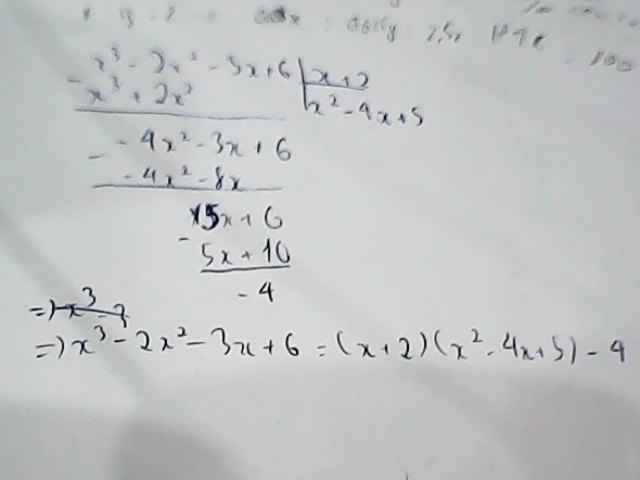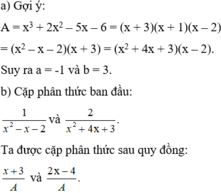
Hãy nhập câu hỏi của bạn vào đây, nếu là tài khoản VIP, bạn sẽ được ưu tiên trả lời.


\(\left(x^3-2x^2-5x+6\right):\left(x+2\right)\)
\(=\left[x^2\left(x+2\right)-4x\left(x+2\right)+3\left(x+2\right)\right]:\left(x+2\right)\)
\(=\left[\left(x+2\right)\left(x^2-4x+3\right)\right]:\left(x+2\right)\)
\(=x^2-4x+3\)

a: ta có: \(x^2+3x-\left(2x+6\right)=0\)
\(\Leftrightarrow\left(x+3\right)\left(x-2\right)=0\)
\(\Leftrightarrow\left[{}\begin{matrix}x=-3\\x=2\end{matrix}\right.\)
b: Ta có: \(5x+20-x^2-4x=0\)
\(\Leftrightarrow\left(x+4\right)\left(5-x\right)=0\)
\(\Leftrightarrow\left[{}\begin{matrix}x=-4\\x=5\end{matrix}\right.\)

Ta có: \(x^3-2x^2-x+2=0\)
\(\Leftrightarrow x^2\left(x-2\right)-\left(x-2\right)=0\)
\(\Leftrightarrow\left(x-2\right)\left(x-1\right)\left(x+1\right)=0\)
\(\Leftrightarrow\left[{}\begin{matrix}x=2\\x=1\\x=-1\end{matrix}\right.\)

a) Đa thức thương x 2 – 6x + 9.
b) Đa thức thương 2 x 2 – 5.
c) Đa thức thương x 2 + 4x + 3 và đa thức dư -12.
d) Đa thức x + 5 và đa thức dư x – 4.

a) ĐKXĐ: \(x\notin\left\{-3;2\right\}\)
b) Ta có: \(P=\dfrac{x^3+2x^2-5x-6}{x^2+x-6}\)
\(=\dfrac{x^3+3x^2-x^2-3x-2x-6}{\left(x+3\right)\left(x-2\right)}\)
\(=\dfrac{x^2\left(x+3\right)-x\left(x+3\right)-2\left(x+3\right)}{\left(x+3\right)\left(x-2\right)}\)
\(=\dfrac{\left(x+3\right)\left(x^2-x-2\right)}{\left(x+3\right)\left(x-2\right)}\)
\(=\dfrac{\left(x-2\right)\left(x+1\right)}{x-2}=x+1\)
Với mọi x nguyên thỏa ĐKXĐ, ta luôn có: x+1 là số nguyên
hay P là số nguyên(đpcm)




\(x^3+2x^2-5x-6=0\)
\(\Rightarrow x^3+3x^2-x^2-3x-2x-6=0\)
\(\Rightarrow x^2.\left(x+3\right)-x.\left(x+3\right)-2.\left(x+3\right)=0\)
\(\Rightarrow\left(x+3\right).\left(x^2-x-2\right)=0\)
\(=\left(x+3\right).\left(x-2\right).\left(x+1\right)=0\)
Trường hợp 1: \(x+3=0\Rightarrow x=-3\)
Trường hợp 2: \(x-2=0\Rightarrow x=2\)
Trường hợp 3: \(x+1=0\Rightarrow x=-1\)